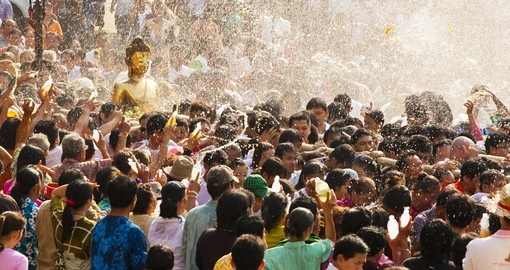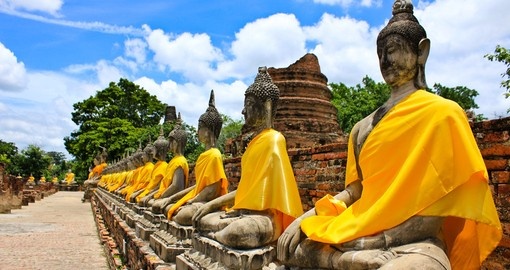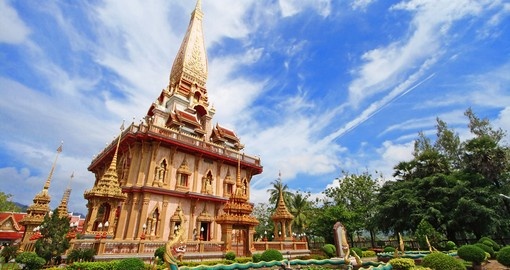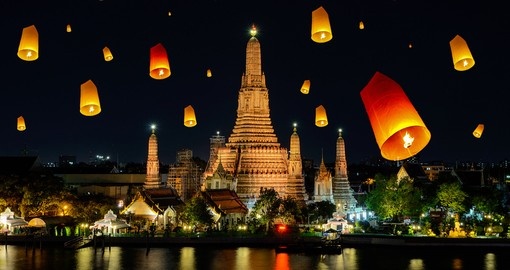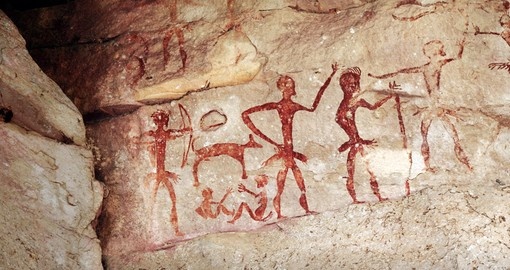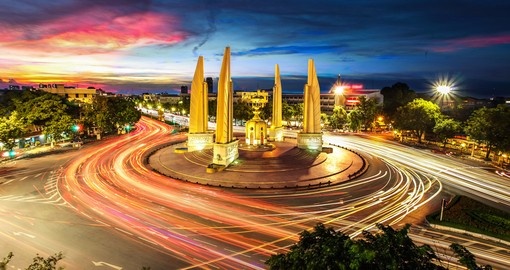Thailand History
Fossilized remains of plants and animals have been found throughout various parts of Thailand. These fossils include dinosaurs that date back to the Jurassic era, as well as from the late Triassic and provide the oldest evidence of dinosaurs in all of Southeast Asia. Lampang Man, a Homo Erectus fossil that resembles early hominids were discovered in the Lampang area of Thailand and dates back some 1,000,000 - 500,000 years ago. Bronze tools and other artifacts that have been unearthed show that there were human settlements in Thailand from 2100-200 BC, spanning the Neolithic Age to the Iron Age.
Between the 6th and 9th centuries, a mysterious Mon civilization known as Dvaravati existed in the country. A great deal of Dvaravati history is still undiscovered, however, it is known that they established remarkable internal and external trade routes that were key to the development of Thailand. The Khmers of Angkor began to expand into Thailand beginning in the 9th century through to the 11th century and much of the Khmer culture was imposed on the populations already living in the country.
The 13th century witnessed the emergence of the Thais as a truly dominant force in the country. In 1238 the Kingdom of Sukthothai was established and with it came Thailand’s “Golden Age”. Beautiful Thai art was allowed to flourish during this time and the Thai alphabet was created. Theravada Buddhism also became the main religion in the country. However, the death of King Khamhaeng, a great supporter of the golden age, in 1298 marked the beginning of the kingdom of Ayutthaya’s dominance in Thailand.
By the middle of the 14th century, the kingdom of Ayutthaya was firmly established in the central plains. Despite periods of Burmese occupation, the kingdom existed until 1767. Ayutthaya sovereigns were absolute monarchs and were called god-kings. They began to exert their power over neighbouring Thai principalities and beginning in the 17th century, they began to make contact with Western countries. A Burmese invasion in 1767 signaled the end of the Ayutthaya kingdom.
The Burmese occupation did not last long courtesy of a young general known as Phya Taksin. Along with his followers, Phya Taksin broke through Burmese lines and within seven months of the initial invasion, had driven Burmese forces out of Thailand. He moved the capital closer to the sea to facilitate foreign trade and to build up fortification against potential future Burmese attacks. When Ayutthaya fell in 1767, it left a lack of central power so General Taksin spent a great deal of time reuniting all the Thai provinces.
The end of the 18th century marked the beginning of the Chakri Dynasty which is the current ruling royal house of Thailand. The capital was moved to Bangkok and the Grand Palace was built. The middle of the 19th century witnessed the beginning of trade relations with western countries as well as with China. King Mongkut Rama took the throne in 1851. While he is famous internationally for being the main character of “The King and I," the musical and the films it inspired were received in Thailand as a mockery of the king and they remain banned to this day. Mongkut Rama is famous in Thai history for modernizing the country through social and economic reforms. He also established treaties with European countries which prevented the colonization of Thailand.
The 20th century saw Thailand change from an absolute monarchy to a constitutional monarchy. A democratic government was established in 1939 and the country changed from being called Siam to Thailand, which means land of the free. Despite siding with the Japanese during the Second World War, Thailand allowed the US to use the country as a base during the Vietnam War.
On 26 December 2004, an earthquake triggered a tsunami that devastated the west coast of the country and is known as one of the deadliest natural disasters ever recorded in history. Despite a great loss of life and infrastructure, Thailand made a strong recovery, and thanks to its many beaches, exciting nightlife, and incredible history, has remained one of the most popular tourist destinations in the world.
Thailand Travel Information
At Goway we believe that a well-informed traveller is a safer traveller. With this in mind, we have compiled an easy-to-navigate travel information section dedicated to Thailand.
Learn about the history and culture of Thailand, the must-try food and drink, and what to pack in your suitcase. Read about Thailand's nature and wildlife, weather, and geography, along with 'Country Quickfacts' compiled by our travel experts. Our globetrotting tips and visa and health information will help ensure you're properly prepared for a safe and enjoyable trip. The only way you could possibly learn more is by embarking on your journey and discovering Thailand for yourself. Start exploring… book one of our Thailand tours today!
Extend Your Trip
After your Thailand vacation, consider taking the time to visit other destinations. Goway offers exciting China vacation packages and India tours plus a comprehensive selection of vacation packages in many other Asian countries.
Book your Thailand tour with Goway!
 ASIA by Goway is an exclusive division that specializes in planning and organizing Thailand tours, vacations, and experiences. Choose from a simple city stopover, a romantic island stay, a stay of distinction, a classic itinerary, an air and land getaway, and much more. We want to be your first choice when next you go globetrotting to Thailand.
ASIA by Goway is an exclusive division that specializes in planning and organizing Thailand tours, vacations, and experiences. Choose from a simple city stopover, a romantic island stay, a stay of distinction, a classic itinerary, an air and land getaway, and much more. We want to be your first choice when next you go globetrotting to Thailand.
Get a Trip Quote Order a Brochure







